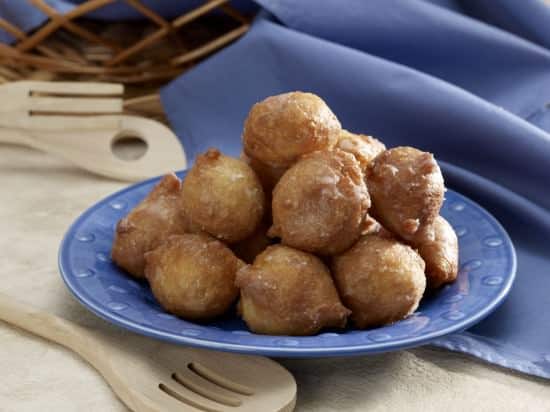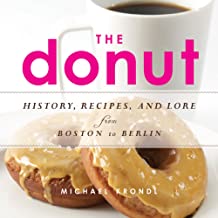The Donut: History, Recipes, and More from Boston to Berlin by Michael Krondl
The donuts-for-Chanukah thing caught me by surprise, and now, having read Michael Krondl’s The Donut: History, Recipes, and More from Boston to Berlin, I understand why.
When I was growing up, nobody in my Ashkenazi Jewish family ever mentioned Chanukah donuts. Potato latkes, yes—fried in oil to recall the time when the victorious Maccabees rededicated the Temple in Jerusalem in 164 BCE; according to the story, the meager supply of oil there lasted for eight days, until more could be procured. But donuts for Chanukah? Nobody in my family knew from that.
[giveaway giveaway_id=1850 side=”right”]Then, some years ago, I noticed people talking about sufganiyot, donuts fried in oil—for Chanukah! I wondered how I had missed this tradition. But Krondl’s book explains that it emerged in post-war Israel, when German and Austrian refugee bakers introduced krapfen—jelly donuts. Krapfen had been popular in Central and Eastern Europe since the 1920s, and were often served for Chanukah. In Israel after the Holocaust, their German name was dropped in favor of a Hebrew one, and a holiday confection was born.
 This is one example of the intriguing doughnut lore unearthed by Krondl, a culinary historian whose Sweet Invention: A History of Dessert was published in 2011. After that, he told me recently, “I’d done these very broad books and I was looking for something where instead of going broad, I could go deep.”
This is one example of the intriguing doughnut lore unearthed by Krondl, a culinary historian whose Sweet Invention: A History of Dessert was published in 2011. After that, he told me recently, “I’d done these very broad books and I was looking for something where instead of going broad, I could go deep.”
In Krondl’s hands, the humble donut proves to be deep indeed. His charmingly readable cultural history of donuts spans the Pharaoh Ramses to Cervantes’ Sancho Panza to Homer Simpson. It offers more than a baker’s dozen of donut tales, from quirky to sublime. (Example: the French sweet, pet de nonne, or nun’s farts.)
A donut, Krondl explained to me, is “any sweet raised dough that’s fried. It can be raised with yeast or baking powder. There’s also the French cruller, which is made with cream puff dough. Its only leavening is eggs and water. I’m on the fence about that.” The cruller, sold in every donut shop, might qualify as a donut, but Krondl draws a line at the fritter, which, he maintains, is any fried dough, leavened or not: “a donut is a subset of a fritter; a fritter is not a donut.”
Not that Krondl gets hung up on semantics, though he traces the name from the original “dough nut” (because of its size and shape) to the shorter doughnut, and finally, donut. Mostly, he’s a storyteller, chronicling donut incarnations around the world. It’s fascinating to see how often the donut has sustained those who labor exposed to the elements, but it makes sense. Says Krondl, “When you’re freezing in the Klondike or in the trenches and your wool uniform is soaking wet and you’re being shot at…it provides you with an immediate fat and sugar high.”
Add a cup of coffee and that portable package of fat and sugar is magic. “If you’re trying to wake up in the morning,” said Krondl, “there really isn’t anything better.”
Zalabia: Syrian Hanukkah Fritters

From The Donut
Krondl writes: “The idea of dipping little donuts into honey goes back at least a couple of thousand years. When the Persians and Arabs adapted the recipe in the early Middle Ages, they substituted sugar syrup, which is still mostly what is used throughout the Middle East and North Africa. Today, each of the Abrahamic religions fries these up for one celebration or another. In Islam, they are common for ending the fast during Ramadan…. In Lebanon, Christians make them for Epiphany. Syrian Jews adopted the fried dough balls for Hanukkah…. My suggestion, if you wish to promote world peace, is to make these for all of the above.”
Makes 4 dozen donuts
Syrup:
- 1 pound (about 2 cups) sugar
- ²⁄³ cup water
- 1½ teaspoons lemon juice
- 1½ teaspoons rosewater or orange blossom water
- Fritter Dough:
- 1 cup lukewarm water (about 105°F)
- ¼ ounce (1 packet) active dry yeast
- 10 ounces (about 2¼ cups) bleached all-purpose flour
- 1 ounce (about 2 tablespoons) sugar
- ¼ teaspoon salt
Oil for frying
- Make the syrup: Combine 1 pound sugar and ²⁄³ cup water in a small saucepan. Bring to a boil and stir until the sugar is completely dissolved. Simmer until the syrup is the consistency of hot honey, about 5 minutes. Remove from heat and cool to room temperature. Stir in the lemon juice and rosewater or orange blossom water.
- Make the batter: In the bowl of a stand mixer fitted with a paddle attachment, combine the lukewarm water and yeast. In a separate bowl, whisk together the flour, 1 ounce sugar, and salt. Gradually beat in the flour mixture. Mix until smooth and a little elastic. Cover with plastic wrap, and let rise in a warm place until double original volume, about 45 minutes. Uncover, and beat once more. Cover, and let rise again, about 30 minutes.
- Using a deep fryer or a heavy pan, heat at least 3 inches of the oil to 360°F. If you’re not using a deep fryer with a built-in thermostat, check the temperature using a candy or deep-fry thermometer.
- Dip two teaspoons in a small bowl of oil to coat. Working in batches, spoon about a teaspoon of batter at a time into the hot oil. Fry, turning occasionally, until puffed, crisp, and golden, about 5 minutes. The light batter produces irregular, rather than round, fritters.
Using a slotted spoon, remove fritters and transfer to a paper towel–lined baking sheet to drain. Warm the syrup to lukewarm. Dip fritters in the warm syrup for about 30 seconds to coat and soak up some syrup. Don’t leave them in too long, though, or they will get soggy. Serve warm or at room temperature.
Buy this Book!
Amazon




